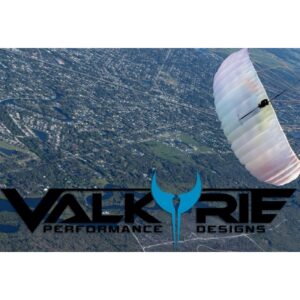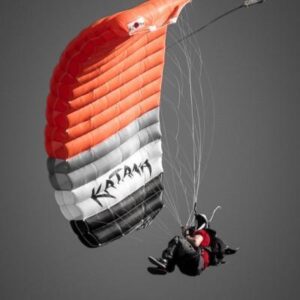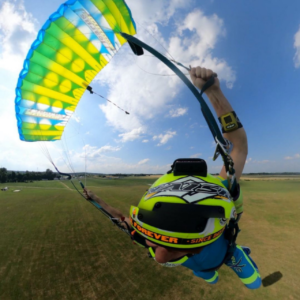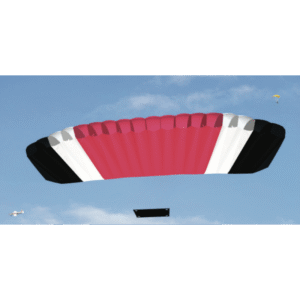PD Navigator Main Parachute Canopy
€2,400.00
Description
PD Navigator Main Parachute Canopy
Navigate with Confidence—Fly with Precision
The PD Navigator main parachute canopy is more than just a beginner-friendly skydiving wing. It’s an innovation developed by Performance Designs to offer smooth, consistent, and confidence-inspiring flight characteristics for new jumpers, instructors, and skydiving schools alike. Whether you’re transitioning from student to solo flyer or guiding first-time jumpers through their AFF, the Navigator delivers predictable flight dynamics, stable deployment, and remarkable landings—even in less-than-perfect conditions.
Developed with input from thousands of instructors and novices worldwide, this canopy was engineered to serve a purpose: to help jumpers learn with less stress and more control. It’s not just reliable—it’s forgiving, stable, and responsive when it matters most.
Design Philosophy: Stability Meets Progression
Tailored for Learning and Longevity
Unlike high-performance canopies that demand precision from the get-go, the PD Navigator main parachute canopy was designed to accommodate human error. It’s tolerant of less-than-perfect body positions and offers margin for error during deployment, flight, and landing. That makes it a go-to canopy for both training centers and individual jumpers building foundational skills.
-
Seven-cell construction ensures maximum stability during all phases of flight
-
ZP (Zero Porosity) fabric maintains performance and canopy integrity over thousands of jumps
-
Heavily tapered nose for consistent pressurization and inflation
-
Wide range of sizes (from 200 to 300 sq. ft.) supports different body types and skill levels
-
Reliable slider and brake settings support smooth openings every time
Through every jump, the Navigator encourages progression while prioritizing safety and ease of use.
Performance That Supports Learning
Openings: Soft and Forgiving
From the moment the canopy deploys, you’ll notice the Navigator’s gentle and reliable opening characteristics. There’s no “slam” or abrupt deceleration. Instead, it gives you a soft, centered deployment that reduces body stress and enhances focus. These ideal opening traits make the PD Navigator especially beneficial for:
-
AFF instructors needing reliable deployments
-
Students managing body position inconsistencies
-
Winds and altitudes that vary from jump to jump
Even when pack jobs aren’t textbook perfect, the Navigator responds with resilience. Instructors consistently praise its durability under repeated, hard-use conditions.
Flight: Smooth, Predictable, and Stable
In the sky, the PD Navigator main parachute canopy performs like a dream. It doesn’t surprise you with erratic movements or sudden dives. Instead, it provides:
-
Low wing loading compatibility for safer, slower flight
-
Responsive yet forgiving controls that help jumpers develop steering techniques
-
Flat glide paths to extend decision-making windows
-
Excellent crosswind and light turbulence handling
Moreover, toggle pressure is balanced—not too stiff to discourage corrections, and not too soft to cause oversteering. That level of responsiveness allows students to build confidence and learn with muscle memory, not just adrenaline.
Landing: Every Descent, a Gentle Touchdown
A canopy that builds confidence should also land with grace. That’s exactly what the Navigator delivers. It brings jumpers down with exceptional flare power, timely response, and stability on approach.
Whether the wind is strong, nonexistent, or shifting, you’ll appreciate how the Navigator holds its heading and reduces lateral drift. The flare window is wide and forgiving, making the canopy effective for both short final adjustments and long, controlled touchdowns.
Instructors know the PD Navigator as a wing that teaches safe landings with consistency, every single time.
Technical Specifications
Performance Designs Engineering in Action
The PD Navigator main parachute canopy integrates thoughtful design elements that blend safety, longevity, and intuitive flight dynamics. Below is a technical breakdown of its configuration:
| Feature | Specification |
|---|---|
| Canopy Type | 7-cell, zero-porosity |
| Size Range | 200 to 300 sq. ft. |
| Fabric | ZP (Zero Porosity) |
| Glide Ratio | Moderate (flat glide, extended range) |
| Flare Power | High |
| Deployment | Soft, reliable, centered |
| Steering Response | Balanced and beginner-friendly |
| Wing Loading Capacity | Optimized for low to moderate ranges |
| Certification | TSO C23d Approved |
Through this intelligent engineering, the Navigator becomes the backbone of AFF programs and personal progression alike.
Ideal For: Who Should Fly the Navigator?
This canopy was designed with a broad audience in mind, yet tailored perfectly for those who are just learning or teaching. It fits beautifully into multiple jump profiles:
For Skydiving Schools:
-
Cost-effective, long-lasting, low-maintenance choice for AFF and solo student programs
-
Versatile enough to support varying body weights and experience levels
-
Highly consistent in both opening and landing performance across multiple jumpers
For New Jumpers:
-
Ideal post-AFF canopy to transition into solo skills
-
Builds confidence through responsive, intuitive feedback
-
Reduces fear factor by emphasizing stability and forgiving flight behaviors
For Instructors and Tandem Professionals:
-
Peace of mind when guiding students on solo flights
-
Reduced chance of off-heading or problematic deployments
-
Robust enough to handle heavy use week after week
Key Highlights at a Glance
✅ Beginner-friendly flight behavior
✅ Durable and rugged ZP fabric construction
✅ Soft, reliable, on-heading openings
✅ Smooth and consistent flare performance
✅ Balanced controls for progression
✅ Wide sizing range to accommodate all jumpers
✅ Designed and tested by Performance Designs
Safety During Flight: Built-In Confidence
Safety is not just a checkbox—it’s the very backbone of the Navigator. From redundant inflation logic in the nose design to predictable recovery arcs, everything about this canopy is tailored for risk reduction. Here’s how it contributes to safer flight:pd pulse
-
Consistent pressurization ensures full inflation, even under student-induced instability
-
Stall-resistant flight dynamics prevent surprises on toggles
-
Generous flare timing means fewer hard landings
-
Easily steerable with harness inputs or toggles
PD’s engineers rigorously tested the Navigator through thousands of real-world skydives, ensuring every aspect of safety has been examined, tested, and confirmed.




Design: Built to Teach, Engineered to Last
Form Meets Function in Flight Training
The PD Navigator main parachute canopy was intelligently designed to be the gold standard for training environments and student progression. Every element, from fabric choice to shape, was crafted with a purpose: to make learning safer, smoother, and more successful.
Instead of borrowing traits from high-performance wings, the Navigator was developed with its own blueprint—one that puts flight stability, progressive handling, and forgiving inputs front and center. Whether on your first solo jump or coaching a full load of AFF students, this canopy’s design instills trust and consistency right out of the container.
Safety During Flight: Confidence in Every Descent
Engineered for Error-Tolerance and Resilience
At the heart of the PD Navigator main parachute canopy lies one core principle: forgiveness equals safety. Every inch of this canopy was purpose-built to reduce risk—not by removing control, but by safeguarding against common student mistakes. From low-altitude flare recoveries to off-heading deployments and body position issues, the Navigator reacts with calm, not chaos.
By designing a wing that instinctively compensates for errors, Performance Designs ensures that each jump becomes a learning opportunity—not a liability.
Inflation Reliability and Heading Control
One of the most dangerous moments in any jump is right after deployment. With the Navigator, this moment becomes a low-stress, consistent experience.
✅ Safety-Enhancing Features at Deployment:
-
Seven-cell design provides superior pressurization even with suboptimal body position
-
Wide-open nose profile promotes quick yet controlled inflation
-
Heading stability reduces canopy twists and recovery issues
-
Slider position and line trim work together to eliminate line dump and slamming
As a result, jumpers are more likely to achieve clean, centered openings, even when deployment body position or pack job is imperfect.pd pulse
Stable Flight, Even Under Pressure
Students often over-input, misjudge altitude, or initiate turns too close to the ground. That’s where the Navigator’s predictive and stable flight behavior becomes a true safety net.pd pulse
✅ Flight Safety Benefits:
-
Resists canopy oscillation during turbulence or misapplied toggles
-
Stall-resistant trim tolerates deeper brake input without sudden collapse
-
Maintains pressurization in turns, reducing risk of asymmetric deflation
-
Harness and toggle inputs remain manageable across the entire flight envelope
This stable design supports corrective learning, not punishment—making each flight safer and more productive.
Landing Safety: Margin of Error Built In
Landing is the most critical moment in any skydive. The PD Navigator shines here by offering a wide flare window, strong flare power, and predictable ground approach, even in tough conditions. Students frequently encounter zero-wind landings or last-minute flare timing confusion. The Navigator mitigates those risks with grace.
✅ Flare & Touchdown Features:
-
Powerful yet smooth flare capability, even at low descent speeds
-
Wide-range brake travel ensures late or early flare doesn’t result in a hard landing
-
Glide profile assists in longer final approaches, giving students more time to react
-
Stable flight near stall point means fewer abrupt transitions before touchdown
Whether landing in tight LZs or forgiving dropzones, the Navigator encourages safe progression, not fear-based learning.
Visual Awareness and Flight Pattern Confidence
Learning how to fly a safe landing pattern is crucial. The Navigator aids this process by offering visual cues and predictable turn behavior:
-
Flat, visible descent path helps students gauge altitude better
-
Smooth turns reduce disorientation during S-turns or braked approaches
-
Consistent glide slope prevents students from overshooting or coming up short
-
Responsiveness to small input teaches fine control without sharp consequences
These features build confidence and situational awareness, two cornerstones of skydiving safety.
Built-In Recovery from Common Mistakes
New jumpers often make the same errors: early flare, missed pattern leg, or asymmetrical input. The Navigator isn’t just tolerant of these—it helps correct them in real-time:pd pulse
-
Late flare still yields a gentle landing due to long flare arc
-
Oversteer correction is smooth and recoverable
-
Low input stalls are avoided due to brake range tuning
-
Off-heading deployments remain stable and recoverable
These in-flight safeguards reduce the chance of injury and increase training retention, leading to a more prepared, more confident next jump.
Safety Endorsements from Professionals
Dropzone owners, instructors, and riggers continually recommend the Navigator as the safest main canopy for training programs. Here’s why they trust it:
-
“It keeps our students safer, which keeps our school running.”
-
“If a student can make a mistake, they will—and the Navigator forgives it.”
-
“I’ve seen it recover from turns that would spin other canopies.”
-
“We’ve had fewer injuries and more solo graduates since switching to the Navigator.”
Backed by thousands of safe landings, these testimonials reflect a canopy that’s not just designed for flight—but for life-saving stability.
Key Design Elements That Set It Apart
Every design feature on the Navigator serves to improve a jumper’s experience during learning, refinement, and even repeated school operations:
✅ 7-Cell Configuration
-
Offers superior heading stability and stall resistance
-
Improves inflation behavior, even in less-than-ideal body positions
-
Naturally flatter glide ratio for longer final approaches
✅ Zero Porosity (ZP) Fabric
-
Retains air pressure for consistent shape across jumps
-
Increases lifespan even under heavy school or rental usage
-
Resists stretching and distortion, maintaining original performance
✅ Contoured Nose Profile
-
Enhances inflation during deployment
-
Maintains pressurization across variable descent speeds
-
Minimizes distortion during turns or braked flight
✅ Reinforced Line Attachments
-
Designed to withstand aggressive student use
-
Reduces line wear and attachment fatigue
-
Supports longevity in commercial training programs
✅ Color-Coded Line Groups and Slider Tabs
-
Assists in faster packing and easier visual inspection
-
Streamlines workflow in busy dropzones
-
Reduces packing errors by less-experienced riggers
Progressive Architecture for Evolving Skills
The Navigator doesn’t just cater to first-jump students. Its internal shaping, control system configuration, and overall layout also make it an ideal step-up canopy as jumpers move from student status into licensed solos.
-
Tapered tail and leading edge deliver just enough maneuverability for real-world practice
-
Long brake line range helps teach effective flare timing and depth
-
Sturdy riser connection points tolerate misrouting or over-input without deforming performance
Performance: Trusted Flight in Every Skydive
Consistency That Builds Confidence
The PD Navigator main parachute canopy delivers performance that new jumpers can count on. From deployment to landing, it exhibits behavior that reduces stress, enhances skill development, and improves flight judgment. Every aspect of its flight profile was engineered to help jumpers build muscle memory and air awareness—without the fear factor.
While some training canopies deliver only passive descent, the Navigator offers true aerodynamic feedback, making it the ideal platform for students and early-license jumpers to learn real canopy control. Whether the goal is mastering a stable straight-in approach or initiating controlled turns, this wing delivers repeatable performance across jump conditions.
Opening: Smooth, Soft, and Reliable
✅ No Surprises—Just Confidence
What separates a great training canopy from a good one? Openings that feel smooth, symmetrical, and safe—even when body position isn’t perfect. The PD Navigator excels here, thanks to:
-
Wide-open nose design for stable inflation
-
Slow, progressive pressurization that prevents hard openings
-
Minimal off-heading tendency, reducing the need for aggressive correction
Moreover, even after repeated use or variable pack jobs, the Navigator maintains opening reliability. Schools report consistent behavior from new packers and experienced riggers alike.
Flight Behavior: Stable, Forgiving, and Encouraging
✅ True-to-Input Control, Tailored for Learning
The Navigator’s flight profile was tuned to offer smooth, docile, and repeatable responses, enabling students to practice with less fear of overcorrection or sudden surges. Key in-air performance traits include:
-
Flat glide ratio for long, manageable approaches
-
Minimal oscillation in turns or turbulence
-
Mild front riser pressure, ideal for early exploration of descent control
-
Balanced toggle pressure, providing tactile input without being overly sensitive
Students feel empowered to explore control surfaces and flight plans, while instructors feel at ease knowing the canopy is built to recover from misjudgments.
Turning and Directional Control
The canopy’s ability to track and recover makes it ideal for refining real-world directional control. It offers:
-
Clear response to harness input, useful for teaching alternative control methods
-
Wide turning arc, encouraging controlled maneuvering rather than snap spins
-
Predictable recovery behavior, even from steep approaches or braked turns
For jumpers learning to manage space and traffic in the pattern, this level of control is indispensable.
Landing: Cushioning Every Step of Progress
✅ Forgiveness Where It Matters Most
Landings are where new jumpers either build confidence—or lose it. Fortunately, the Navigator supports progress with landing characteristics designed to forgive late flares, uneven control inputs, and windy conditions.
-
Impressive flare power across all sizes
-
Stable, non-twitchy approach behavior, even in gusty winds
-
Wide flare window that tolerates early or late brake input
-
Solid recovery arc, assisting in smoother transitions from glide to touchdown
This is especially important for schools, where jumpers often experience their first low- or zero-wind landings. The Navigator ensures they walk away upright and encouraged, not bruised or shaken.pd pulse
Versatility in Conditions
Real-world training conditions are rarely perfect. That’s why the Navigator was designed to perform reliably across a wide range of wind speeds, temperatures, and field layouts. Whether you’re jumping at sea level or altitude, in warm thermals or humid ground haze, the canopy remains stable and trustworthy.pd pulse
-
Handles moderate turbulence without collapse or excessive input
-
Resistant to canopy distortion in uneven airflow
-
Adapts well to various jumper weights thanks to broad wing loading range
You can trust this wing to provide consistent performance across changing environments and skill levels.
Instructor and DZ Feedback
In performance reviews from dropzones worldwide, the Navigator consistently earns praise from instructors and safety officers. Here’s what they love most:
-
“You always know what the canopy will do next.”
-
“Our students progress faster because they’re not afraid of the wing.”
-
“The flare power is incredible for a 7-cell canopy.”
-
“It makes coaching pattern work and landings easier.”
This direct field feedback reinforces what PD engineered from the start: a canopy that delivers practical, consistent, high-value performance for training centers, rental fleets, and progressing skydivers.performance design
Technical Specifications: Performance in Every Thread
Engineered for Reliability and Progression
The PD Navigator main parachute canopy incorporates cutting-edge construction and material choices from Performance Designs, ensuring durability, consistency, and student-centric performance. Whether used for tandem transitions or solo development, this canopy is built to deliver under pressure—again and again.performance design
From cell configuration to line trim, every technical aspect of the Navigator reflects a singular focus: supporting newer skydivers while optimizing for longevity and minimal maintenance. Here’s a complete breakdown of what makes the Navigator a technical powerhouse in the training canopy category.performance design
Core Technical Features
| Component | Specification |
|---|---|
| Canopy Type | 7-cell rectangular canopy |
| Construction Material | Zero Porosity (ZP) nylon |
| Canopy Sizes | 200, 220, 240, 260, 280, 300 sq. ft. |
| Wing Loading Range | 0.75 – 1.20 lbs/ft² (depending on size and jumper weight) |
| Line Type | 550 lb Spectra or 825 lb Dacron (varies by configuration) |
| Slider | Standard collapsible or non-collapsible mesh slider |
| Deployment Sequence | Designed for smooth, symmetrical, and soft on-heading openings |
| Brake Line Range | Extended to accommodate wide flare timing and student-style inputs |
| Riser Compatibility | Standard 3-ring system |
| Certification | TSO C23d approved |
Construction Materials & Durability
✅ Zero Porosity (ZP) Nylon
-
Minimizes airflow leakage through the canopy surface
-
Enhances pressurization, leading to more consistent flight behavior
-
Greatly increases usable canopy life span under intensive use
✅ Reinforced Stitching
-
Double-needle and bar-tack reinforced stress points
-
Designed to resist deformation under heavy brake input or abrupt riser pulls
-
Withstands hundreds of student jumps with minimal degradation
✅ Line Options
-
Spectra Lines: Offer lower drag and lighter handling
-
Dacron Lines: Provide increased visibility and tolerance for misrouting
-
Both line types are readily replaceable and color-coded for simplicity
Canopy Trim and Glide Dynamics
-
Flat glide configuration ensures more forward speed in no-wind or downwind landings
-
Mild front-riser pressure allows canopy pilots to begin exploring controlled descent techniques
-
Wide flare window accommodates student reaction times and instructor cueing
-
Low stall point engineered to delay sudden canopy collapse in flare practice
The technical trim decisions made in the Navigator allow jumpers to explore real-world canopy behavior while maintaining safety and control. Students can confidently execute flat turns, braked approaches, and off-target recoveries without risking canopy instability.pd pulse
Deployment System Compatibility
The Navigator is built to integrate seamlessly with the most common deployment configurations in modern training systems:PD Navigator Main Parachute Canopy
-
Main pilot chute types: Suitable for 28”–32” collapsible or throw-out pilot chutes
-
Deployment bags: Standard BOC (bottom-of-container) or student-specific configurations
-
Risers: Compatible with stainless or soft-link risers and 3-ring systems
-
Sliders: Mesh and collapsible options available to match your preferred deployment speed
Canopy Size and Wing Loading Guide
| Canopy Size (sq. ft.) | Ideal Exit Weight (lbs) | Recommended Wing Loading (lbs/ft²) |
|---|---|---|
| 200 | 150 – 180 | 0.95 – 1.10 |
| 220 | 160 – 190 | 0.90 – 1.05 |
| 240 | 170 – 210 | 0.85 – 1.00 |
| 260 | 180 – 230 | 0.80 – 0.95 |
| 280 | 190 – 250 | 0.75 – 0.90 |
| 300 | 200 – 270 | 0.70 – 0.85 |
Note: These figures represent common use cases for student and post-AFF jumpers. Always consult with a certified rigger or canopy coach for personalized sizing advice.PD Navigator Main Parachute Canopy
Maintenance & Lifecycle Efficiency
With thousands of jumps logged on a single Navigator in school environments, this canopy has earned its reputation as a workhorse in both structure and flight. Key durability notes include:
-
ZP fabric maintains performance far longer than F-111 alternatives
-
Simple line replacement and slider swaps extend service life
-
Minimal trim change over time thanks to smart engineering and line routing
-
Lower total cost of ownership due to reduced need for re-lines or patchwork
This technical depth ensures the PD Navigator delivers not just a safe ride, but a well-structured platform for student learning, instructor peace of mind, and school operational efficiency.
This unique blend of precision and permissiveness is why instructors repeatedly choose the Navigator as their go-to student and post-AFF canopy.
Designed by Performance Designs—Backed by Decades of Data
No design element on the PD Navigator main parachute canopy is accidental. Each decision—from cell count to seam angle—was driven by field data, instructor feedback, and real-jump analytics. Performance Designs ran hundreds of prototypes and real-world trials to refine its:
-
Glide characteristics
-
Turn responsiveness
-
Flare effectiveness
-
Inflation consistency
-
Stall behavior
Thanks to this detailed R&D, the Navigator is more than a parachute—it’s a teaching tool embedded in fabric and lines, purpose-built to shorten the learning curve while extending the safety margin.
Frequently Asked Questions (FAQ)
Q1: Is the PD Navigator suitable for first solo jumps?
Yes, the Navigator is specifically designed for student progression. Its forgiving flight characteristics and reliable openings make it ideal for first solo and early post-AFF jumps.
Q2: What sizes are available and how do I choose?
Sizes range from 200 to 300 sq. ft., accommodating a variety of jumper weights and wing loadings. Consult your instructor or rigger for personalized sizing based on your exit weight and skill level.
Q3: How durable is the Navigator canopy?
Constructed from Zero Porosity (ZP) fabric and reinforced stitching, the Navigator offers exceptional longevity, even under heavy school use. It withstands thousands of jumps with proper maintenance.
Q4: Can I use the Navigator for advanced maneuvers?
While the Navigator excels as a training canopy, it supports progressive control inputs, allowing jumpers to safely develop basic turning and flare techniques. However, it’s not intended for high-performance or acrobatic flight.
Q5: What maintenance does the Navigator require?
Regular inspections, line replacements, and proper packing are essential. Thanks to its rugged design, the Navigator typically requires less frequent repairs compared to other student canopies.
Comparison: PD Navigator vs. Other Student Canopies
| Feature | PD Navigator | Typical Student Canopies |
|---|---|---|
| Opening Behavior | Soft, centered, and reliable | Variable; some hard openings |
| Fabric | Zero Porosity (ZP) for durability | Often lower quality or mixed fabrics |
| Flare Power | High for a 7-cell, enabling softer landings | Moderate; may result in harder landings |
| Flight Stability | Exceptionally stable and forgiving | Can be prone to oscillations |
| Line Durability | Reinforced line attachments and quality lines | May require frequent replacements |
| Suitability for Training | Designed with instructors and students in mind | Varies; some designed more for fun fly |
| Lifespan | Thousands of jumps with proper care | Often less durable under school use |
| Control Responsiveness | Balanced; encourages progressive learning | Can be too sensitive or too dull |
Why Choose the PD Navigator?
The PD Navigator stands out as the definitive choice for jumpers seeking a safe, durable, and easy-to-fly training canopy. Its design balances performance with forgiveness, giving learners a stable platform that evolves with their skills. Instructors trust it for the consistency it delivers; students appreciate the confidence it builds. When safety, longevity, and learning are priorities, the Navigator is your wing of choice.
Additional information
| Size | 200, 220, 240, 260, 280, 300 |
|---|





Reviews
There are no reviews yet.